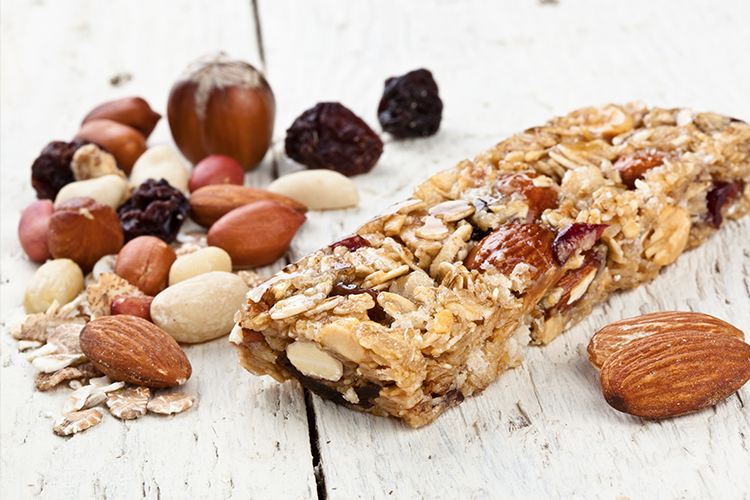Blog
What is in our snack bars?
 Browsing the supermarket aisle, the warm, natural and rustic tones of the packet of muesli bars cries healthy, nourishing and goodness.
Browsing the supermarket aisle, the warm, natural and rustic tones of the packet of muesli bars cries healthy, nourishing and goodness.
And this is exactly what these food manufacturers want you to believe.
However, a recent review by Choice of 224 snack bars – including muesli, cereal, raw and nut bars – found that looks can be deceiving. While we think we are onto a good thing, we may be packing in the added sugars, despite the appearance, claims and health star rating.
This review supports our continued work to encourage people to adopt the World Health Organisation’s recommendations, limiting added or free sugar intake to 6tsp (25g) per day for added health benefits, and reducing risk of teeth decay, obesity and a raft of other potential health ramifications.
As for the snack bars – who ranked well, and who did not?
The healthier snacks
Generally, cereal, nut or raw bars that ranked highly were those that comprised mostly of real food – no added sugars, no (or minimal) additive, colours or flavourings.
And those with the least amount of overall sugar appear to be mostly comprised of whole foods, like nuts, seeds and dried fruit, offering protein, good fats, fibre and even some minerals and vitamins. Brilliant!
Some examples are the Well Naturally No Sugar Added Cereal Bar (Almond Sesame Seed Linseed) containing 1.4g of sugar per 35g serving, and the Food for Health Cinnamon Hazelnut & Chia Bars 2g per 25g serving.
The 247 snack bar range, like the Dark Chocolate, Coconut & Almond Crunch, are also low in sugars containing 1.2g per 40g serving, but have slightly more complicated ingredient list than those above!
What can be difficult to determine, however, is what is added sugar and what are naturally occurring sugars within that total sugar amount. We will discuss this in a moment – but first, which snack bars didn’t get the healthy thumbs up?
The not-so-healthy snacks
The packaging claims ‘contains fruit!’ and is coupled with images of fresh, delicious looking berries, apple or banana. But often the fruit is a concentrate or flavouring. Not actual fruit, whether fresh or dried.
Not only that, many bars contain additives and colours that perhaps needn’t be there!
When looking at added sugars, here are some dudes you want to look out for:
- Go Natural Macadamia Dream containing 4.5tsp per 50g serving
- Kellogs LCM Split Stix containing 2tsp per 23g serving
- Carman’s Oat Slice Belgian Chocolate Brownie containing 2.5tsp per 35g serving
- Weight Watchers Coconut Delight Indulgent containing 2tsp per 21g serving.
Those with poor nutritional quality overall, including a high amount of added sugars, included Woolworths Homebrand Oven Baked Fruit Bars Apple & Blueberry, Go Natural Nut Delight Yoghurt Fruit Nuts, Coles Nut Bars Choc Coated Nut, Kelloggs Nutri-Grain, Fontelle Oven Baked Mini Meal Choc Chip, and several of Carmen’s oat slice varieties.
What determined their poor rating was based on the current Health Star rating guidelines, including high energy density (Fontelle’s offering above contains 2,412kj!) and added sugar content, but also the salt and saturated fat content.
On the other end of the spectrum, some bars with high sugar levels seem to obtain their super sweet status due to the bulk of the product being dried fruit, but not added sugars. Dried fruit, whilst it can be high in sugar, at least contains some fibre to help slow the absorption of sugar into the bloodstream. These included:
- Kez’s Free & Naked Banana Cake 52.8g/100g
- Go Natural Raw Cacao Fruit Nut Cherry Coconut 50.6g/100g
- Golden Days Nude Food Cacao 50.2g/100g
- Emma & Tom’s Life Bar Cacao & Coconut 44.6/100g
These bars also contained little, if any, proteins and fat, which doesn’t help the overall sugar status.
Claims, labelling and seeking added sugars
Calls for clear labelling on how much of the sugar content in manufactured food and drink is added, and how much is naturally occurring, is something we at That Sugar are well and truly advocating.
As it currently stands in Australia, it is difficult to ascertain what sugars are present as part of the composition of an ingredient – like lactose in yoghurt, or fructose in dried fruit – and what percentage is comprised of added sugars – like fruit juice, cane sugar, honey or other syrups.
As mentioned in the Choice report, it can be difficult to decipher! But check out the ingredient list, as for example, the sugar content in the Go Natural Macadamia Dream Bar is pretty much ONLY added sugar; whereas the sugar from Emma and Tom’s Life Bar Cacao and Orange is only from dried fruit. As mentioned, whilst dried fruit is still a concentrated source of sugar, it is teamed with fibre which can help slow the absorption into the bloodstream. But don’t go overboard – sugar to the body is sugar!
So, what’s a snacker to do?
If buying a pre-packaged/pre-made food or drink, take a peek at the ingredient list for added sugars. The higher on the ingredient list, the greater percentage it will make up the total sugar content.
The inclusion of nuts and/or seeds is often good way boost nutritional content and keep you feeling satisfied, whilst minimising any big hit to blood glucose levels due to added fat and protein content.
And whilst many of these products claim to contain fruit, perhaps we should get back to basics and snack on a piece of fruit instead?
Try an apple sliced with your favourite 100% nut butter, have a banana, or enjoy berries and plain dairy or coconut yoghurt. Or snack on savoury goodies! Boiled eggs, a small tin of tuna, or veggie sticks with hummus can be super satisfying – and leave you feeling fuller for longer!
Check out our Low Sugar Snacks e-book for more inspiration 🙂
For more, please see the full article by Choice.com.au.
By Angela Johnson (BHSc Nut. Med.)











